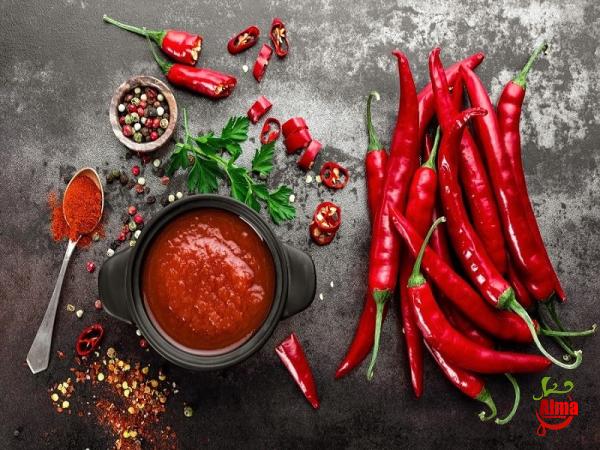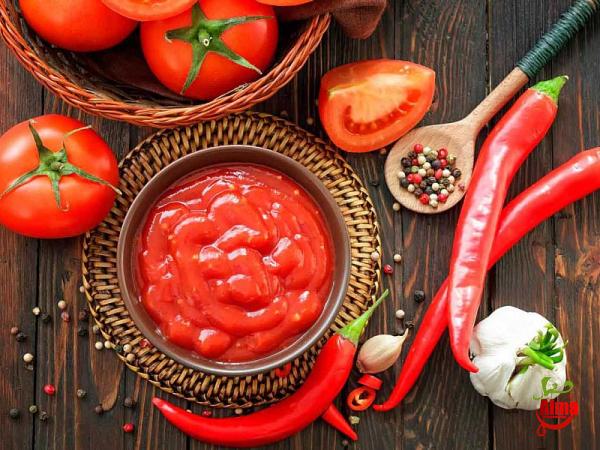The Role of Tomato Sauce or Paste in Chili: A Flavorful Culinary Tradition Introduction: Tomato-based sauces are an essential ingredient in many cuisines worldwide, adding depth, richness, and tanginess to numerous dishes. In the context of chili, the inclusion of tomato sauce or paste plays a pivotal role in enhancing the flavors and textures of this beloved comfort food. This article explores the significance of tomato-based products in chili, their historical origins, variations, and tips for incorporating them into this classic dish. Understanding Tomato Sauce and Paste: Tomato sauce and tomato paste are both derived from tomatoes but undergo slightly different processing methods, resulting in variations in their flavor, consistency, and culinary applications. Tomato sauce is made by cooking tomatoes with various herbs, spices, and occasionally with additions like onions and garlic, resulting in a liquid, pourable consistency. On the other hand, tomato paste is a concentrated form of tomato sauce, formed by cooking tomatoes for a longer duration and removing most of the moisture, leading to a thicker, more intense product. Historical Significance of Tomato Sauce in Chili: The origins of chili can be traced back to the indigenous people of the Americas, who have been utilizing chili peppers in their cooking for centuries. While the concept of chili has evolved over time, the inclusion of tomato-based products like tomato sauce or paste can be attributed to the influence of Spanish and Mexican culinary traditions. These ingredients not only act as a flavor enhancer but also provide a balanced base and a pleasant tang to the dish. Flavor Profile Enhancements: Tomato sauce or paste brings a multitude of benefits to chili, primarily from a flavor perspective. The natural sweetness of tomatoes counters the heat of chili peppers, creating a harmonious balance. The acidity in tomatoes adds a tangy component, complementing the richness of meat and other spices used in chili recipes. Additionally, the umami-rich profile of tomatoes contributes to the depth and complexity of the overall flavor, ensuring a delicious end result. Texture and Appearance: The consistency of tomato sauce or paste has a significant impact on the texture and appearance of chili. Tomato sauce adds a desirable level of thickness without overpowering the other ingredients, resulting in a hearty and velvety texture. For individuals who prefer a chunkier chili, incorporating tomato paste may be a better option, as its concentrated nature maintains tomato bits in the dish. The vibrant red color of tomato-based sauces adds visual appeal to the chili, making it all the more appetizing. Variations in Tomato Sauce or Paste Usage: While tomato sauce and paste are commonly used in chili, the choice of one over the other depends on personal preference and regional variations. Some chili connoisseurs prefer to use tomato sauce as it lends a lighter, smoother texture to the dish, allowing other ingredients to shine. In contrast, others opt for tomato paste which provides a more pronounced tomato flavor and a thicker consistency. Exploring different variations is an enjoyable way to discover individual taste preferences.

tomato paste
 Incorporating Tomato Sauce or Paste in Chili Recipes: When incorporating tomato sauce or paste in chili recipes, it is crucial to strike a balance between the tomatoes and other ingredients, ensuring that one does not overpower the other. To achieve a well-rounded profile, it is recommended to simmer the sauce or paste with other chili ingredients, such as ground meat, beans, onions, garlic, and a blend of spices. This way, the flavors meld together, resulting in a harmonious and robust chili. Other Considerations: While tomato-based sauces significantly enhance chili, it’s important to note that some individuals may have dietary restrictions or taste preferences that require alternative options. In such cases, tomato-free variations of chili can be explored using alternative ingredients like roasted vegetables, white sauces, or even cocoa powder, creating a unique flavor profile. Conclusion: The inclusion of tomato sauce or paste in chili recipes has become an integral part of this beloved culinary tradition. From adding depth and richness to balancing flavors, tomato-based products offer an array of benefits to chili enthusiasts worldwide. Whether opting for a smoother texture with tomato sauce or a more intense flavor with tomato paste, the versatile nature of these ingredients allows for endless variations and customization. So the next time you prepare a steaming pot of chili, remember to incorporate tomato-based products, and savor the delightful fusion of flavors that they bring to this classic comfort food.I. Tomato Sauce or Paste in Chili: A Thriving Market The use of tomato sauce or paste in chili has not only become a culinary tradition but also a thriving business market. The demand for ready-to-use tomato-based products in the form of sauces or pastes is continuously growing, driven by the popularity of chili and the convenience they offer to home cooks and foodservice establishments alike. 1. Rising Consumption of Chili: Chili has gained immense popularity globally, with people seeking out its comforting, spicy flavors. This growing interest in chili has contributed to an increased demand for tomato sauce or paste as an essential ingredient. As more individuals incorporate chili into their regular meals, the market for tomato-based products in chili has expanded.
Incorporating Tomato Sauce or Paste in Chili Recipes: When incorporating tomato sauce or paste in chili recipes, it is crucial to strike a balance between the tomatoes and other ingredients, ensuring that one does not overpower the other. To achieve a well-rounded profile, it is recommended to simmer the sauce or paste with other chili ingredients, such as ground meat, beans, onions, garlic, and a blend of spices. This way, the flavors meld together, resulting in a harmonious and robust chili. Other Considerations: While tomato-based sauces significantly enhance chili, it’s important to note that some individuals may have dietary restrictions or taste preferences that require alternative options. In such cases, tomato-free variations of chili can be explored using alternative ingredients like roasted vegetables, white sauces, or even cocoa powder, creating a unique flavor profile. Conclusion: The inclusion of tomato sauce or paste in chili recipes has become an integral part of this beloved culinary tradition. From adding depth and richness to balancing flavors, tomato-based products offer an array of benefits to chili enthusiasts worldwide. Whether opting for a smoother texture with tomato sauce or a more intense flavor with tomato paste, the versatile nature of these ingredients allows for endless variations and customization. So the next time you prepare a steaming pot of chili, remember to incorporate tomato-based products, and savor the delightful fusion of flavors that they bring to this classic comfort food.I. Tomato Sauce or Paste in Chili: A Thriving Market The use of tomato sauce or paste in chili has not only become a culinary tradition but also a thriving business market. The demand for ready-to-use tomato-based products in the form of sauces or pastes is continuously growing, driven by the popularity of chili and the convenience they offer to home cooks and foodservice establishments alike. 1. Rising Consumption of Chili: Chili has gained immense popularity globally, with people seeking out its comforting, spicy flavors. This growing interest in chili has contributed to an increased demand for tomato sauce or paste as an essential ingredient. As more individuals incorporate chili into their regular meals, the market for tomato-based products in chili has expanded.
Specifications of tomato paste
 2. Convenience and Time-Saving: In today’s fast-paced world, convenience is key. Tomato sauce or paste allows home cooks to save time and effort, as they no longer need to prepare tomatoes from scratch. Ready-to-use tomato-based products in the form of sauces or pastes provide a convenient solution, enabling people to enjoy homemade-style chili without the lengthy preparation process. II. Market Trends and Opportunities The market for tomato-based products in chili is not only driven by the traditional use of tomato sauce or paste but also by the evolving culinary preferences and consumer demands. Several market trends and opportunities have emerged, providing avenues for innovation and growth within the industry. 1. Organic and Natural Options: With increasing awareness about health and sustainability, there is a growing demand for organic and natural products. Manufacturers have recognized this trend and have responded by offering organic tomato-based products for chili enthusiasts who prefer to use ingredients that are free from pesticides and artificial additives. 2. Ethnic and Regional Flavors: As the culinary landscape becomes more diverse, there is a rise in the demand for ethnic and regional flavors. Tomato-based products infused with traditional spices and seasonings are catering to consumers seeking an authentic taste experience. From Tex-Mex to Indian-inspired chili, these variations provide a unique twist to the classic dish. 3. Customization and Personalization: Consumers today value customization and personalization in their food choices. The availability of tomato-based products in various flavors, including spicy, smoky, or tangy, allows individuals to tailor their chili according to their taste preferences. Manufacturers have recognized this trend and cater to a wide range of flavor profiles to meet the individual needs of consumers. III. Market Challenges and Competition While the market for tomato sauce or paste in chili presents numerous opportunities, it is not without its challenges. Manufacturers in this space face competition and must address key industry challenges to maintain their market share and meet customer demands.
2. Convenience and Time-Saving: In today’s fast-paced world, convenience is key. Tomato sauce or paste allows home cooks to save time and effort, as they no longer need to prepare tomatoes from scratch. Ready-to-use tomato-based products in the form of sauces or pastes provide a convenient solution, enabling people to enjoy homemade-style chili without the lengthy preparation process. II. Market Trends and Opportunities The market for tomato-based products in chili is not only driven by the traditional use of tomato sauce or paste but also by the evolving culinary preferences and consumer demands. Several market trends and opportunities have emerged, providing avenues for innovation and growth within the industry. 1. Organic and Natural Options: With increasing awareness about health and sustainability, there is a growing demand for organic and natural products. Manufacturers have recognized this trend and have responded by offering organic tomato-based products for chili enthusiasts who prefer to use ingredients that are free from pesticides and artificial additives. 2. Ethnic and Regional Flavors: As the culinary landscape becomes more diverse, there is a rise in the demand for ethnic and regional flavors. Tomato-based products infused with traditional spices and seasonings are catering to consumers seeking an authentic taste experience. From Tex-Mex to Indian-inspired chili, these variations provide a unique twist to the classic dish. 3. Customization and Personalization: Consumers today value customization and personalization in their food choices. The availability of tomato-based products in various flavors, including spicy, smoky, or tangy, allows individuals to tailor their chili according to their taste preferences. Manufacturers have recognized this trend and cater to a wide range of flavor profiles to meet the individual needs of consumers. III. Market Challenges and Competition While the market for tomato sauce or paste in chili presents numerous opportunities, it is not without its challenges. Manufacturers in this space face competition and must address key industry challenges to maintain their market share and meet customer demands.
buy tomato paste
 1. Intense Competition: The market for tomato-based products in chili is highly competitive, with several established players and new entrants vying for market share. Manufacturers must differentiate their products through unique flavors, quality ingredients, and innovative packaging to stand out in a crowded marketplace. 2. Price Sensitivity: Price sensitivity is another challenge in the tomato-based products market. With numerous brands and options available, consumers are often price-conscious. Manufacturers must balance the cost of production while ensuring a competitive price point that appeals to consumers without compromising on quality. 3. Supply Chain Management: The procurement and management of tomatoes for sauce or paste production can be challenging. The availability and quality of tomatoes can fluctuate due to factors such as weather conditions, disease outbreaks, and market dynamics. Manufacturers need to establish robust supply chain management systems to ensure a steady and reliable source of tomatoes, especially during peak demand seasons. IV. Product Innovation and Expansion To thrive in this competitive market, manufacturers of tomato-based products in chili need to continuously innovate and expand their product offerings. Product innovation allows manufacturers to capture new segments of the market and differentiate themselves from competitors. 1. Health-Focused Offerings: As health-consciousness continues to rise, manufacturers can tap into this trend by developing healthier options of tomato-based products. Low-sodium, reduced-sugar, or even gluten-free variations cater to specific dietary needs and preferences, expanding the target market. 2. Premium and Gourmet Products: To target consumers willing to pay a premium for high-quality and unique products, manufacturers can develop gourmet or artisanal versions of tomato-based sauces or pastes. These offerings can feature premium ingredients, specialized flavor profiles, and distinctive branding, catering to a niche market segment. 3. Diversification in Packaging: Packaging plays a vital role in product appeal, convenience, and shelf-life. Manufacturers can explore innovative packaging solutions such as resealable pouches, single-serve portions, or eco-friendly materials to provide added convenience and reduce waste. Packaging that extends the shelf-life of tomato-based products also ensures freshness and increases customer satisfaction. V. Conclusion The use of tomato sauce or paste in chili has evolved into a thriving business market, driven by the increasing popularity of chili and consumer demand for convenient, ready-to-use products. Market trends such as organics, ethnic flavors, and customization present opportunities for manufacturers to tap into new segments and cater to evolving consumer preferences. However, challenges like competition and price sensitivity require strategic planning and innovation to maintain a strong market position. By staying attuned to market trends, developing innovative products, and expanding their offerings, manufacturers of tomato-based products in chili can navigate the complex landscape and meet the demands of chili enthusiasts around the world.
1. Intense Competition: The market for tomato-based products in chili is highly competitive, with several established players and new entrants vying for market share. Manufacturers must differentiate their products through unique flavors, quality ingredients, and innovative packaging to stand out in a crowded marketplace. 2. Price Sensitivity: Price sensitivity is another challenge in the tomato-based products market. With numerous brands and options available, consumers are often price-conscious. Manufacturers must balance the cost of production while ensuring a competitive price point that appeals to consumers without compromising on quality. 3. Supply Chain Management: The procurement and management of tomatoes for sauce or paste production can be challenging. The availability and quality of tomatoes can fluctuate due to factors such as weather conditions, disease outbreaks, and market dynamics. Manufacturers need to establish robust supply chain management systems to ensure a steady and reliable source of tomatoes, especially during peak demand seasons. IV. Product Innovation and Expansion To thrive in this competitive market, manufacturers of tomato-based products in chili need to continuously innovate and expand their product offerings. Product innovation allows manufacturers to capture new segments of the market and differentiate themselves from competitors. 1. Health-Focused Offerings: As health-consciousness continues to rise, manufacturers can tap into this trend by developing healthier options of tomato-based products. Low-sodium, reduced-sugar, or even gluten-free variations cater to specific dietary needs and preferences, expanding the target market. 2. Premium and Gourmet Products: To target consumers willing to pay a premium for high-quality and unique products, manufacturers can develop gourmet or artisanal versions of tomato-based sauces or pastes. These offerings can feature premium ingredients, specialized flavor profiles, and distinctive branding, catering to a niche market segment. 3. Diversification in Packaging: Packaging plays a vital role in product appeal, convenience, and shelf-life. Manufacturers can explore innovative packaging solutions such as resealable pouches, single-serve portions, or eco-friendly materials to provide added convenience and reduce waste. Packaging that extends the shelf-life of tomato-based products also ensures freshness and increases customer satisfaction. V. Conclusion The use of tomato sauce or paste in chili has evolved into a thriving business market, driven by the increasing popularity of chili and consumer demand for convenient, ready-to-use products. Market trends such as organics, ethnic flavors, and customization present opportunities for manufacturers to tap into new segments and cater to evolving consumer preferences. However, challenges like competition and price sensitivity require strategic planning and innovation to maintain a strong market position. By staying attuned to market trends, developing innovative products, and expanding their offerings, manufacturers of tomato-based products in chili can navigate the complex landscape and meet the demands of chili enthusiasts around the world.









Your comment submitted.